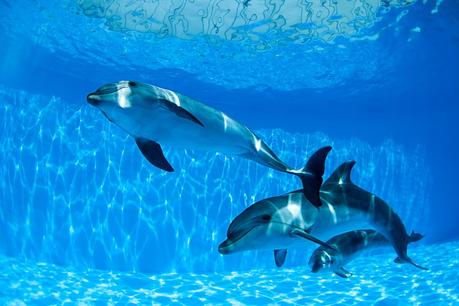
It doesn’t take much looking these days when exploring travel options to come across adventures involving animals. There are LOTS of photos of people smiling with a wide variety of animals from their travels and adventures.
You can swim with dolphins in Hawaii, stingrays (San Antonio, TX Sea World),and even sharks (Disney Aulani in Kapolei, HI)! On every continent there are animals to encounter and experiences to add to your memories – riding camels in Morocco, and even communing with llamas at a petting zoo at a rodeo in Houston, Texas. Animals are everywhere and travelers of all ages love them, especially children.
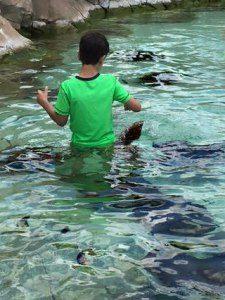
Swim with dolphins: Animals are a big part of the world!
My daughter recently said that one day when we go to Egypt she wants to ride a camel. Thinking she forgot that we rode camels in Morocco, I reminded her. She replied, “Mom, I know…(in that eye rolling tone only a tween can muster) but I want to ride an Egyptian camel.” I chuckled to myself, but had to agree…an Egyptian camel would be a great part of an Egyptian adventure.
Don’t dolphins and stingrays come to mind when you think of islands and warm oceans? Don’t snake charmers come to mind when you think of Morocco? Lions and tigers when you think of Africa? Bears and Alaska? Animals are big part of what we love about travel. Getting to know them better is a part of your adventure.
Swim with dolphins: There are healthy programs for animals.
In addition to all the photos of people with animals on their travels, there is a LOT of talk about how ‘bad’ and ‘inhumane’ programs are that offer interaction between humans and animals. Really every day I read pleadings from blogs and articles asking others not frequent them as animals are being harmed. Animal programs are listening. For example, Sea World has ended it’s killer whale breeding program.
Are animal interaction programs ALL bad for animals? No. Are animal interaction programs ALL good for animals? Of course not. Nothing is ever that simple. But, connecting humans with animals is valuable and so seeking out ways for ethical interactions is important.
According to the American Veterinary Medical Association:
“The human-animal bond is a mutually beneficial and dynamic relationship between people and animals that is influenced by behaviors that are essential to the health and well-being of both. This includes, but is not limited to, emotional, psychological, and physical interactions of people, animals, and the environment.”
In simple English, humans and animals belong together and have from the earliest of times. Researchers note that even in our earliest art, such as that in Lascaux, France, there are many examples of animals. On the island of Hawaii you can see ancient petroglyph carvings and animals are included there, too. Animals are important to us.
Swim with Dolphins: We benefit from interaction with animals.
Seeing animals in person, rather than on TV or in a book, helps children develop compassion. In person, you see that animals are real living beings with feelings and family relationships, just like us. Cartoons often paint an inaccurate portrait of animals. Looney Tune roadrunner cartoons are a classic example because no matter how many times the coyote gets squished or blown up he never really gets hurt.
People naturally care more about what they know. So, when kids learn about animals in an up close and interactive way especially, they will care about those animals. Giving your child the opportunity to care for other beings is a true gift. After a dolphin encounter you come away with information about water conservation – not for ‘some vague reason’ but for the very dolphin that you swam with – the one your child fed and talked to. The message is a million times more powerful.
Give your child an opportunity to learn in new and different ways than in a traditional school day. Schools are set up for mass quantities of learning and lots and lots of students. When your child gets a chance to interact with animals without the masses, you can deliver information in a custom way. Hands on is the greatest way to learn!
Swim with Dolphins: Dolphin Quest – Hilton Waikaloa Village on the island of Hawaii
Recently we were in Hawaii and had the opportunity to swim with the dolphins. We weren’t at all sure of what to expect, but we explored the center as we waited our turn. We found marine biologists happily tending to the aquariums and energetically teaching visitors all about the marine life around the islands of Hawaii.
Next, we saddled up with life vests and masks and listened to the rules regarding our visit with the dolphin. Our life vest helper happily shared with us all the details of the program – how long it had been there, how many gallons the ocean area for the dolphins held and how they were fed. I was curious why there were other fish swimming around not being eaten for snacks. Why don’t the dolphins eat the other fish? It turns out that dolphins get fed only the very best fish – sushi grade. This way, the trainers know the food fish are healthy and won’t give their dolphins any ‘germs’. Those ordinary fish swimming around in the dolphin area are safe from being eaten as these dolphins have a super duper diet which they obviously prefer.
Our dolphin trainer, Lauren, was one of the most energetic and happy people I have ever had the pleasure to meet. To say she loves her life and her job is to put it mildly – joy and happiness literally pours out of her very being. She excitedly told us we were going to meet her very favorite dolphin ever. She had the smile and joy that a new mom would have to show off her baby.
Lauren explained the water was open to the ocean and so the other fish in it naturally swam in but that the water was also filtered constantly. This was very clean and fresh water. It was clear that these animals were given the very best situation for their health.
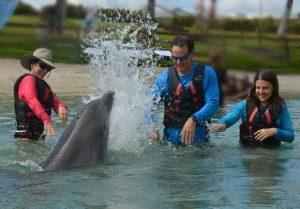
The dolphins enjoy three living areas. The largest is also the one where guests visit. It is shallow, but the depth that this type of dolphin, the Atlantic bottlenose, enjoys in the wild. Dolphins are rotated through the areas to give them a break from tourists and each other. They are separated in different combinations so they can enjoy relationships separately. The smaller areas, where they take their breaks have toys. I always thought of toys as something they use for their ‘shows’ or for interactions with tourists, but not so this time. The dolphins had toys if they wanted them. I saw one pushing around what looked like a boogie board just for fun.
When we met baby dolphin, Lehua, it was truly an awe inspiring moment to be near such a large creature. Having never been so close I was surprised at how very BIG this baby was. We petted her and interacted with her. The joy and excitement reminded me of how excited I would get when my kiddos were little. Remember the moment your little learned to walk? That is the reaction the trainer showed the dolphin. That dolphin was enjoying her trainer. You can even see Lehua’s birth on you tube!
The trainer, Lauren, told us what to do to indicate the behavior or ‘trick’ we wanted and Lehua, the baby dolphin, reacted. It was so much like playing peek a boo with a small child. The baby dolphin was happy to play with us. We clapped and cheered when she performed and we marveled at such a creature. Humbling moment.
Swim with dolphins: Do your own research!
So, of course not all animal interaction programs are good, but what category (religion/food/fashion/transportation) in the world can you think of that is entirely good? I can’t think of a single one. So, research animal encounters and choose a good one. You’ll know when you find the right one for your family just like you know if a daycare program or camp for your child is a good one.
Read the reviews – you can read the Trip Advisor reviews for Dolphin Quest – 800 reviews and 4.5 stars out of 5! Read the research and check it out with your own eyes. Is it clean and everyone is happy because natural needs are being met?
Swim with dolphins: Animal encounters are worth the effort!
The Hilton Waikaloa Village is home to the Dolphin Quest where you will find all sorts of opportunities to meet the dolphins. Have an encounter with a group or a small encounter with just your family. Or, be a trainer for a day!
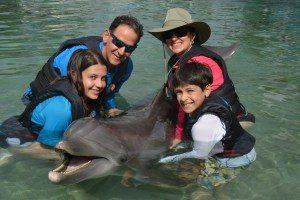
Don’t be afraid to have animal encounters. They aren’t all bad. The people who run the programs aren’t all mean to the animals. In the case of Dolphin Quest at the Hilton Waikaloa Village, the exact opposite is true. The animals have a much longer lifespan in the loving care of the marine biologists than they do in the wild. Daily health checks, loving trainers, and sushi grade food, and no predators = long lifespans for dolphins.
Swim with dolphins: Dolphins and people – we are more alike than you think.
Dolphins give each other names. They have distinct whistles for members of their family pod. The teenagers even call each other poop face and stupid just like humans! (OK, I made that part up, but….once you interact with them and see how amazing they really are….it is easy to imagine them acting like human tweens.)
Our genome (DNA) is almost identical. Isn’t that hard to believe? But, it is true. A&M researcher, David Busbee compared human DNA with dolphin DNA and found just a few ways that the genetic material is put together in different arrangements that create our differences.
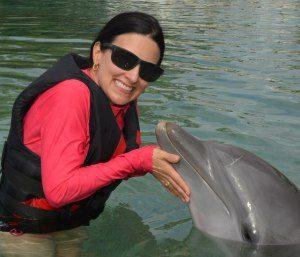
Dolphins have self awareness. You’ve seen the funny cat videos when a cat sees himself in the mirror and reacts like it is a different cat. The cat in NOT self aware. When you look at yourself in the mirror you know the reflection is you – not a different person. A dolphin has this ability to recognize itself in the mirror, too – just like you do!
Swim with dolphins: Dolphin Quest is ethical, sustainable, and an amazing program.
Rest assured that this program, Dolphin Quest at the Hilton Waikoloa Village on Hawaii, is a healthy one for dolphins and people alike – learn, explore, experience with a clear conscience. You don’t even have to be staying at the Hilton to participate.
Enjoy your adventures and feel good about the choices you make!

